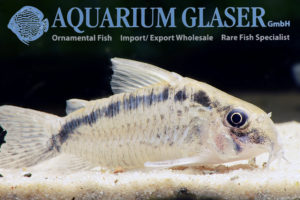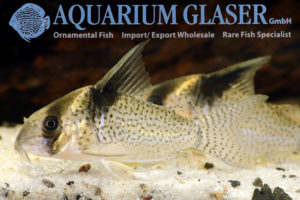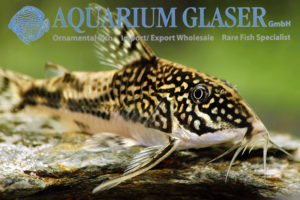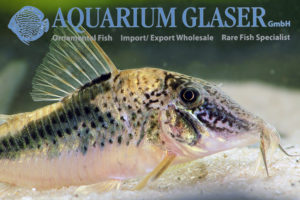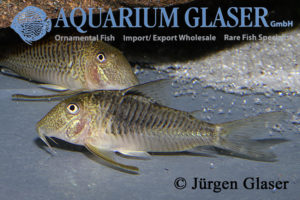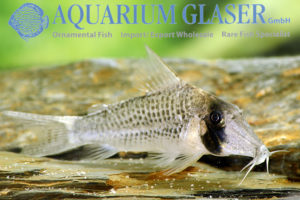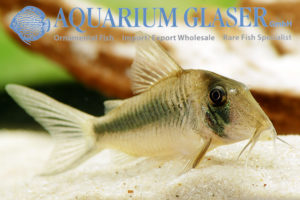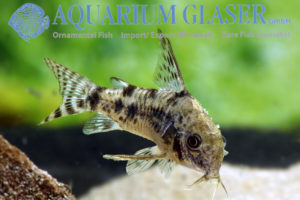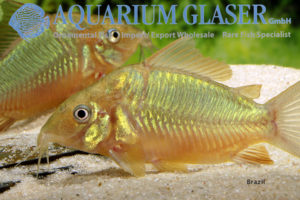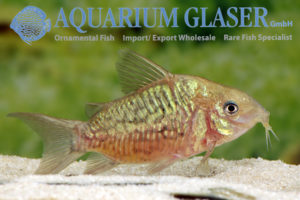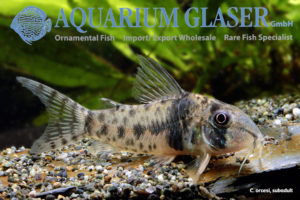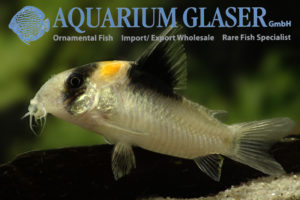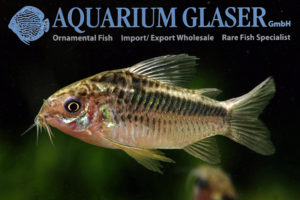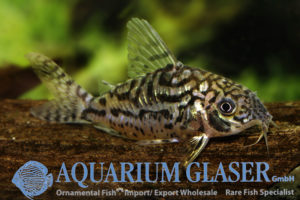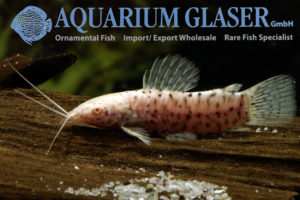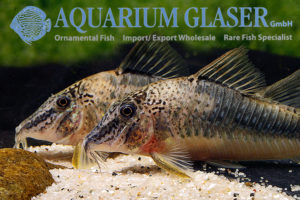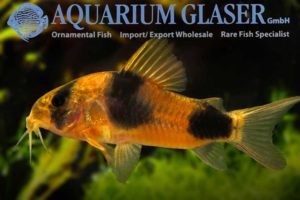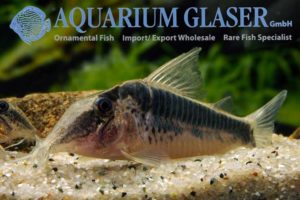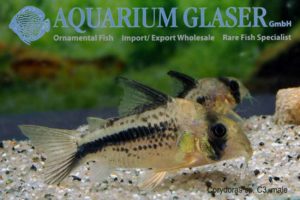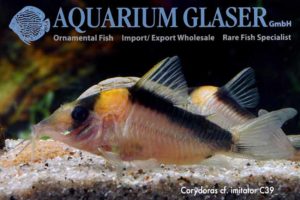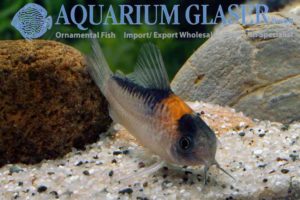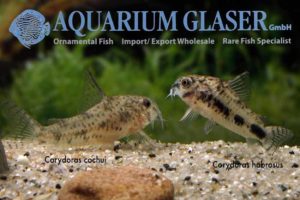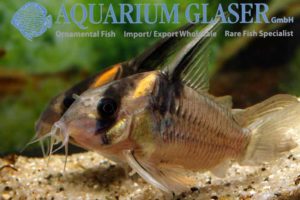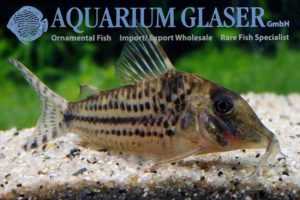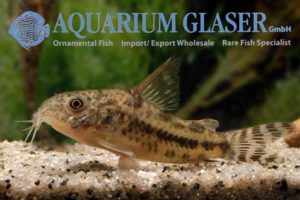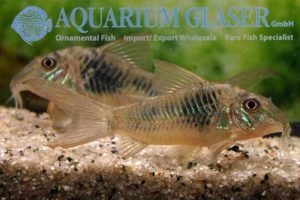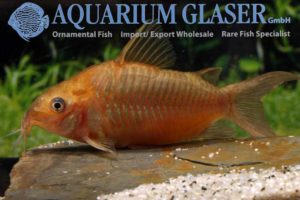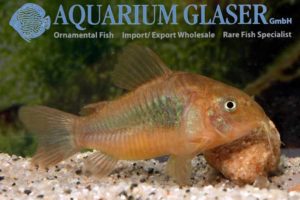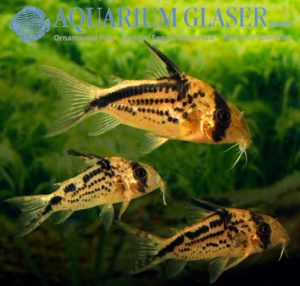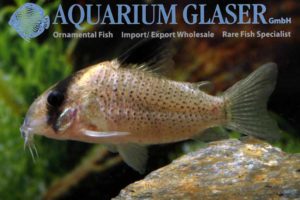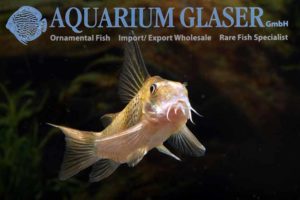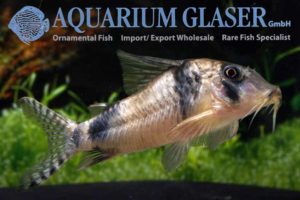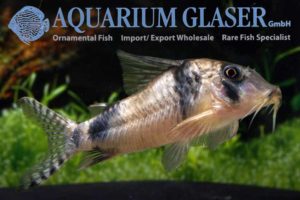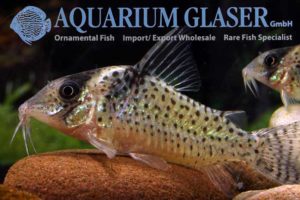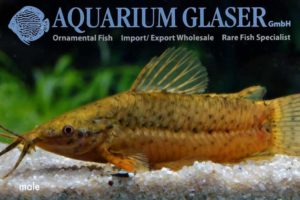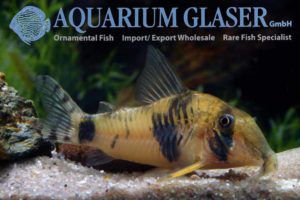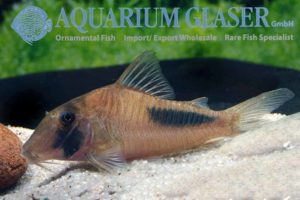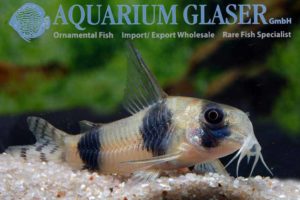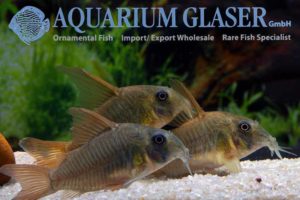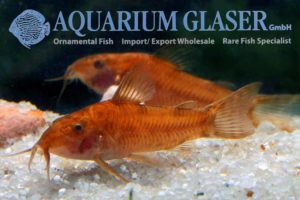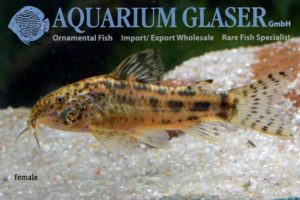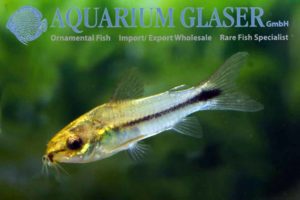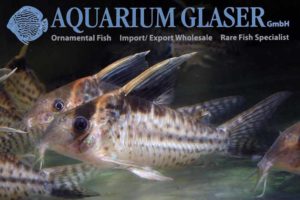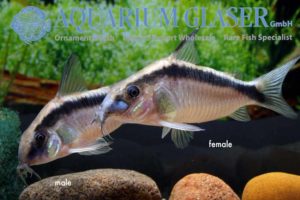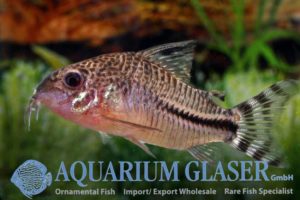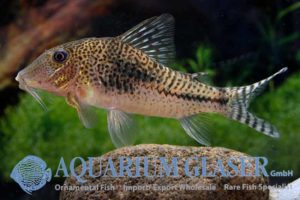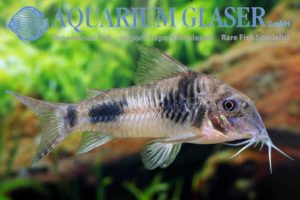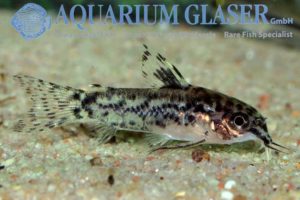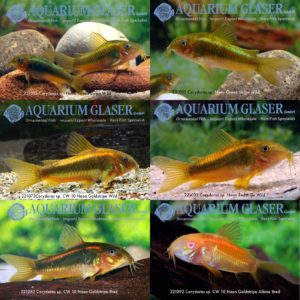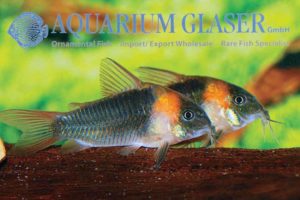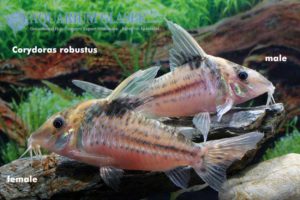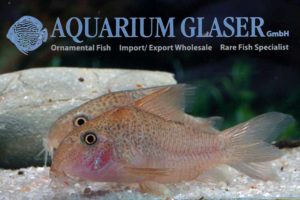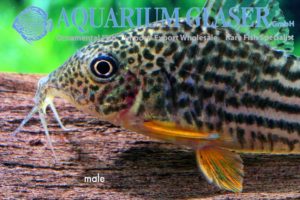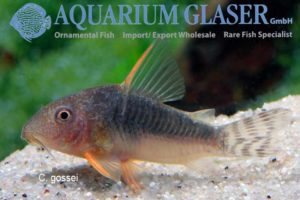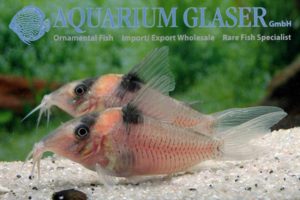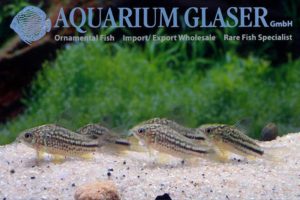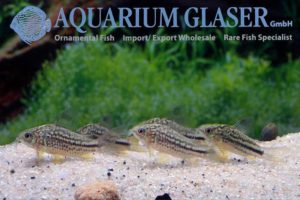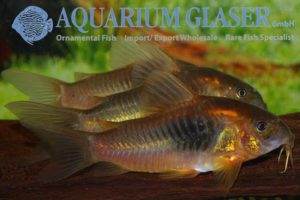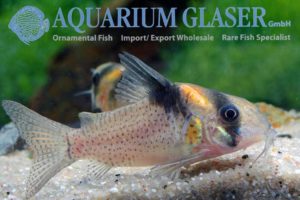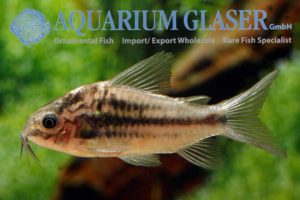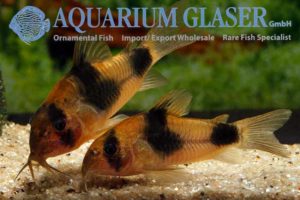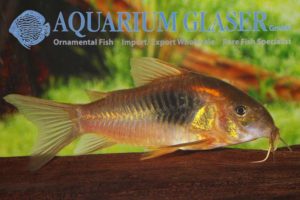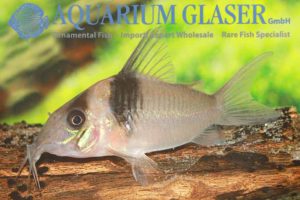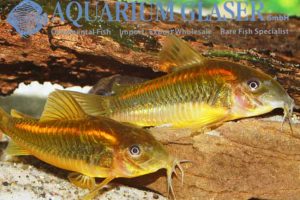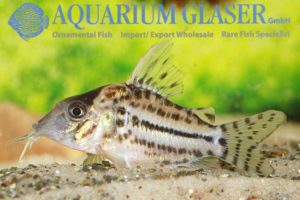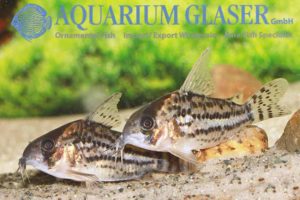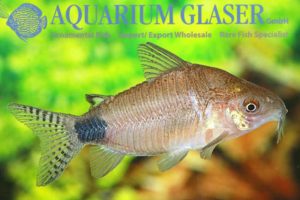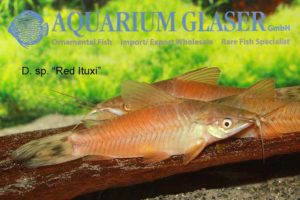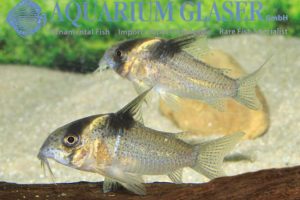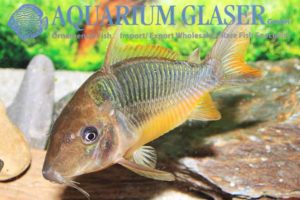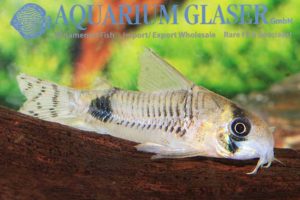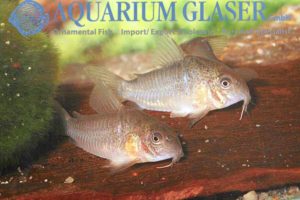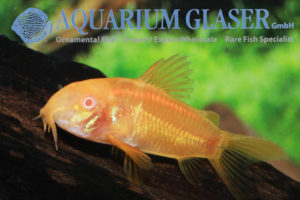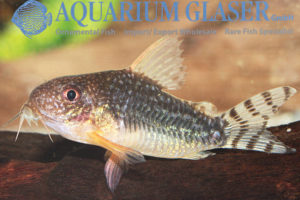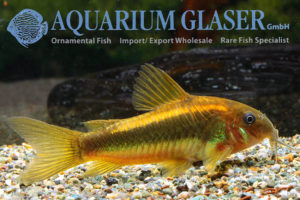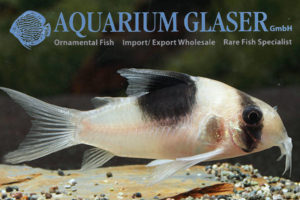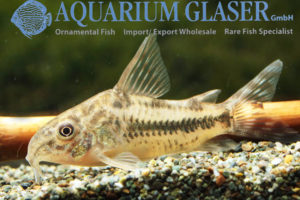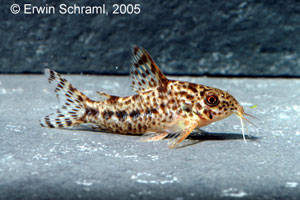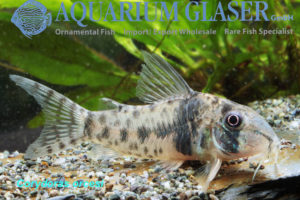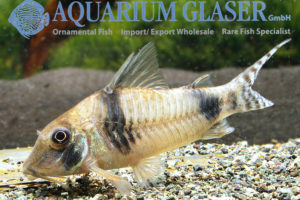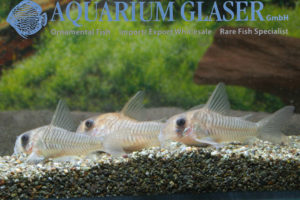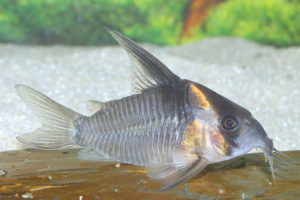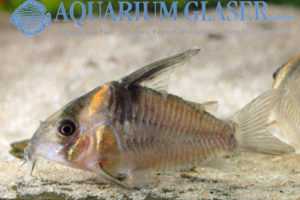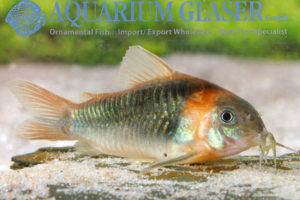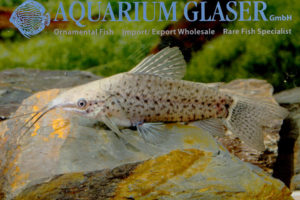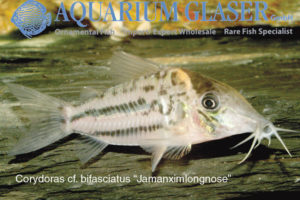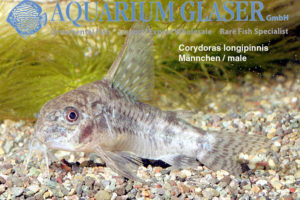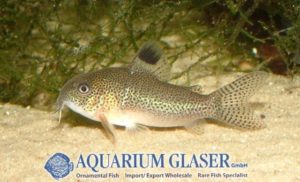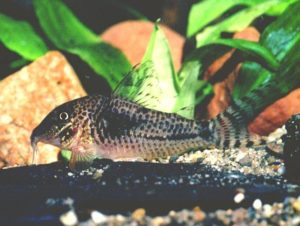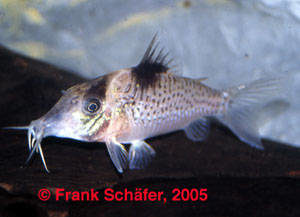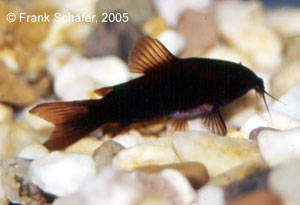Once again we were able to import a new catfish, whose identity raises many questions. The fish were offered to us as Corydoras evelynae, a species that was described by only one specimen with a very inaccurate location (“upper Solimoes”, which includes an area larger than Germany). Our new imports were collected in the surroundings […]
10a. Catfishes: Corydoras & Co. (209)
-
-
Corydoras sp CW 98
This beautiful Corydoras belongs to a scientifically undescribed species. It originates from the upper Rio Negro in Brazil. Because of the bright orange neck spot it is usually misidentified as Corydoras burgessi, which also comes from this region, especially as C. burgessi has a very variable pattern and there are also spotted colour variants of […]
-
Scleromystax barbatus
No doubt: this cory from the south of Brazil, where it inhabits cool blackwater brooks near the coast, is among the most beautiful species of cory at all. Sadly it is not exported from Brazil currently. Keeping this fish is usually problem-free, but breeding is due to the high demands (cool, very clean water with […]
-
Corydoras fowleri Variant
Corydoras fowleri is a very rare and very beautiful species of Corydoras. The species originates from Peru. It is well known for its high degree of variability in respect of coloration. Our latest import contained specimens that looked very different from their conspecifics. They have a strong golden-bronze coloration of the neck and an overall […]
-
Corydoras geoffroy
For a very long time this species of Corydoras – the type species of the entire genus! – was a myth. Until now it is a top-rarity among the corys. So we are extremely glad that our proofed breeder for special cases, Kurt Jülich, was successful in breeding with wild collected specimens. We can offer […]
-
Corydoras sp. aff. sychri Longnose C53
From the Rio Nanay in Peru originates a species-flock of very similar looking corys. They are distinguished externally basically by the shape of the head and the snout. All of them are very beautiful and suited very well for the aquarium. All have an impressive dark mask over the eye and clear fins. The body […]
-
Corydoras amapaensis
The beautiful long snouted Corydoras amapaensis is a top rarity in the ornamental fish trade. Only very occisonally, every 5-6 years, some specimens can be imported. So we are very glad that we can offer now for the first time some bred ones. The fish are currently about 4 cm long and have just reached […]
-
Corydoras longipinnis
We were able to import an interesting Corydoras species from Paraguay, namely Corydoras longipinnis. This species has been scientifically described as recently as 2007 by Joachim Knaack. The new species is a close relative to the well known Corydoras paleatus and reminds one somewhat of the longfinned sport of that species. In Corydoras longipinnis only […]
-
Brochis splendens and B. cf. splendens CW 35
Currently is a top season for large, breathtaking Green Cats, Brochis splendens. We have two varieties in stock which are collected in areas that have roughly 1.200 km distance from each other. The one comes from Peru and represents the „typical“ B. splendens. The species has been described scientifically from the Rio Tocantins in Brazil; […]
-
Corydoras pantanalensis
Currently we can offer one of the most beautiful and most splendid species of Corydoras, namely C. pantanalensis. Before its scientific description it was known as C5. This species attains a body length of about 8 cm and is one of the largest species of Corydoras. Within the genus, C. pantanalensis belongs to a relationship […]
-
Corydoras orcesi and C. pastazensis
These beautifully marked species appeared only very occasionally in the aquarium hobby. Corydoras orcesi has been described from the Rio Tigre system in Ecuador. Initially it was described as a subspecies of the similar Corydoras pastazensis. However, so far no intergrades have been found and this makes it very likely that both are seperate species. […]
-
Corydoras burgessi
Now the season for the very beautiful and much beloved orange blotch corys has started. There does exist a good number of different species and varietoies, all have in common a brightly shining spot on the neck. Depending on light this glows from yellow to almost red. This glowing spot helps the fish in the […]
-
Corydoras elegans “Peru”
We received a small number of this pretty cory from Peru. It was shipped under the nice name „Corydoras Brilliante“. In fact the dark longitudinal band of the fish shines in a bright emerald green when the reflecting light comes in the correct angle, but all in all the fish is „only“ a local variety […]
-
Corydoras sodalis
We received beautiful coloured Netted Corys. The species Corydoras sodalis is quite often imported, but mostly under the completely wrong name of Corydoras punctatus. The real C. punctatus originates from Surinam, occurs hardly ever in the trade and looks very similar to the well known species C. julii and C. trilineatus. A cory that can […]
-
Megalechis thoracata „Albino“
The Port Hoplo Megalechis thoracata – maybe the synonym (now invalid) name Hoplosternum thoracatum is more familar to some readers – is one of the earliest aquarium fish at all. The fish has only one real disadvantage: the maximum size, which is about 15 cm (or sometimes even larger). However, the species has a comparatively […]
-
Corydoras fowleri / coriatae
The very long snouted Corydoras fowleri has been described scientifically in 1950 on the basis of a single specimen. Since that it has not been seen for decades anymore. Only at the end of the 1990ies imports from Peru arrived. The imported fish proofed to be very variable in respect of coloration. It is still […]
-
Corydoras weitzmani WILD
We received a shipment of beautiful, fully grown wild collected Corydoras weitzmani from Peru. The species is extremely rare in the trade. Our fish have a perfect condition! There were strong doubts not long ago that the species might not exist at all or that it has been extinct. This was due to the fact […]
-
Corydoras cf. semiaquilus Alto Blanco
The number of Corydoras species can hardly be overlooked anymore. There are 218 species described scientifically, 159 C-numbers, and 122 CW-numbers currently known. However, some very distinct forms can be easily separated from this mass and for sure a new genus must be erected for these once a revision of the complete genus is made. […]
-
Corydoras sp. C3
Shipments declared as “Corydoras deckeri” from Colombia are always subject of surprise. There is no scientifically described species C. deckeri, this name is pure fantasy. So sometimes Corydoras axelrodi, sometimes C. loxozonus, and sometimes the scientifically undescribed C. sp. C3 are shipped under that flag. This time we received the pretty C3. However, all three […]
-
Corydoras imitator and C39
Currently we receive imports of “Corydoras imitator” from the upper Rio Negro in Brazil. If one takes a close look on the fish it becomes obvious that hardly two specimens look really identical. Coloration is variable, as well is the shape of the body. Some fish, for sure, are unplanned by-catches, for example C. incolicana […]
-
Corydoras njisseni
Finally we were able to import again the smallest and cutest of all the different “orange blotch” Corydoras from the Rio Negro: Corydoras nijsseni. This fish is a close relative of C. elegans. The coloration, which is the same in Corydoras adolfoi, C. duplicareus, C. imitator, C. sp. C39, C. serratus, and serveral other species, […]
-
Corydoras cochui and C. habrosus
These dwarf species of Corydoras have been confused quite a long time. Both species attain a maximum length of about 3 cm and a very cute, nice and lively aquarium fish. If one has the opportunity to see live specimens of both species together it may be hard to understand how they may be confused; […]
-
Corydoras CW 45 Lessex
We can currently offer a very limited number of a new variety of the rare species CW 45. The fish was named “Lessex” by the exporter. We adopted that name, but we don´t know the meaning. CW 45 is a deep bodied species, similar to C. armatus. It differs from the latter by the bright […]
-
Corydoras vittatus
And here we have one more beautiful species of currently imported Corydoras. Corydoras vittatus – the specific name means “striped” – is one of the most variable species in respect of the individual pattern. The fish originates from Brazil. Formerly it was often regarded to be a subspecies of the also very variable species Corydoras […]
-
Corydoras diphyes and Otocinclus mimulus
Corydoras diphyes and Otocinclus mimulus are available irregularly in Germany and have been recently described by Axenrot and Kullander (2003). They originate from the tributary of the Rio Monday, a river flowing into the Rio Parana in Paraguay. This species was known, for quite a long time, as Corydoras flaveolus in the hobby; this species, […]
-
Unusual ornamental fish bred in Indonesia 2: Corydoras septentrionalis
Corydoras septentrionalis is rather rare in the trade. It occurs in Venezuela and Colombia. The species is very similar to Corydoras ellisae from Paraguay. It differs from C. ellisae mainly due to the much longer snout and the colourless fin (with a spotted pattern in C. ellisae). We were a bit surprised to obtain that […]
-
Corydoras pantanalensis C5
This species is one of the largest of its genus: C. pantanalensis can reach a total length of more than 8 cm! Now we finally were able once more to import these splendid pieces of gold in small numbers. Besides the impressive size Corydoras pantanalensis is also very interesting because the males develop during the […]
-
Corydoras aeneus Cuiabá
The Bronze Cory is the most popular and most widespread Corydoras in the hobby. This stands in a strong contrast to the scientific knowledge about the systematics of that species. From a systematist´s point of view the Bronze Cory is among the least understood species of the genus. Currently only one species is accepted, which […]
-
Corydoras loxozonus
This cory belongs to the most attractive members of the genus Corydoras and is also very easy to keep. One should only remember that C. loxozonus – it originates from the Rio Orinoco and its affluents – prefers higher temperatures. So the water temperture should not sink below 25°C for longer. Currently we can […]
-
A brandnew Corydoras – Corydoras sp. aff. potaroensis
Sometimes it’s hard to believe. If one reminds that currently 160 species of Corydoras are scientifically accepted, plus 159 C-numbers, plus 107 CW-numbers, it is more than likely that every newly imported Corydoras could be applied to at least one of these fish. But far from that! Last week we obtained Corydoras under the name […]
-
Corydoras armatus Venezuela
Corydoras armatus belongs to the species of Corydoras which are known by scientists very long already. It represents the sixths described species of the genus. The original descriprition appeared back in 1868. The type specimens originated from Peru (Rio Huallaga). It is quite astonishing that the species appeared comparatively late in the hobby – in […]
-
Corydoras sp.
The longsnouted and saddle-nosed Corydoras appear in the wild either solitary or in small schools. This is the reason why they are much more difficult to collect than the round-nosed Corydoras which most often live in very large swarms. This fact makes the longsnouted and saddle-nosed Corydoras much more expensive and also more desired by […]
-
Corydoras sp.
Another extremely rarely imported Corydoras species reached us from Peru. The unusual popular name of the scientifically undescribed species is due to the coloration, especially the dark triangle in the neck. This reminds one very much to the odd type of headdress worn by Gustaf Gründgens in his legendary production of Goethe´s Faust, where he […]
-
Corydoras crimmeni
For the first time ever we can offer this beautiful Corydoras. It originates from the Rio Negro basin in Brazil. A bright green shine on the flanks of the body is very obvious, especially when the light falls from ahead on the fish. This species attains a maximum length of about 6.5 cm. For our […]
-
Lepthoplosternum pectorale – Dwarf Hoplosternum
The Hoplosternum relationship belongs to the plated catfish and and is thus closely related to Corydoras & Co. Like these, they make good and interesting aquarium fishes. Sadly most species become quite large. So, the species of the genus Lepthoplosternum are the best choose for smaller tanks. The maximum size of the members of that […]
-
Corydoras sp. Tukano Longnose
There are still species of Corydoras that are imported so rarely and in so low numbers that the fish stay unfulfilled dreams of most enthusiasts. One of the most attractive species of that group is for sure the “Tukanao Longnose”. Of course these animals are not rare in the wild in the sense that there […]
-
Corydoras amapaensis
Finally we were able to import again a small number of the extremely rarely offered long snouted Corydoras amapaensis. The species is highly variable in respect of coloration. The sexes can be distinguished best by the shape of the spines of the pectoral fins, which are thickened and hairy in males. For our customers: the […]
-
Corydoras tukano
Hard to believe but true: it took five long years until we were able now to import once more Corydoras tukano. Now this pretty fish is finally available again. We obtained very stable, beautiful animals. For more information and how to distinguish C. tukano from its close relative C. reynoldsi, please see http://www.aquariumglaser.de/en/fish-archive/corydoras-en/_en-5/ For our […]
-
Corydoras concolor
We received really beautiful Corydoras concolor in a perfect size (md-lg) from Colombia. The sexually active males develop very pretty high fins. For our customers: the fish have code 226004 on our stocklist. Please note that we exclusively supply the wholesale trade. Text & photos: Frank Schäfer
-
Aspidoras sp. C125 Red
Yesterday we introduced to you the pretty Aspidoras taurus (see http://www.aquariumglaser.de/en/news/Aspidoras_taurus_en/). We received from the very same breeder for the first time the very nice albinotic red variety of Aspidoras sp. C125. The wild coloured variety looks quite similar to A. taurus, but the fish stays a bit smaller (4-4,5 cm). According to our breeder […]
-
Aspidoras taurus
This pretty species of catfish is found only very occasionally in the trade. The species is not allowed to be exported from Brazil currently, so exclusively bred specimens are traded. We just received a small number of the attractive species from one of our breeders. Aspidoras taurus reaches a maximum length of about 5-6 cm. […]
-
Corydoras pygmaeus
The Dwarf corydoras (Corydoras pygmaeus) belongs without any doubts to the most attractive and interesting aquarium fish for small tanks. This dwarf becomes only 2-3 cm long and is a somewhat untypical member of its genus, for most species of Corydoras are bottom dwellers; C. pygmaeus prefers to swim in the open water column. Interestingly […]
-
Corydoras robustus
This cory belongs to the largest and most attractive species of Corydoras at all. They can reach a total length of 9-10 cm. Both sexes develop long, filamentous dorsal fins when fully grown. The males can be best recognized by the much longer ventral fins. For our customers: the fish have code 244106 on our […]
-
Corydoras sp Super Arcuatus
Finally we received again this gorgeous, rare species of Corydoras from the Rio Purus in Brazil. The fish become almost double size compared with the “common” Corydoras arcuatus. In any other respect both species can be handled the same: they are hardy and beautiful fish! For our customers: the animals have code 221855 on our […]
-
Corydoras sp. Manu5 (CW062)
Currently we received a number of still undescribed species of Corydoras from the Madre de Dios region in Peru, among them the very pretty Corydoras sp. Manu5. The Rio Manú is the larger of the two headstreams of the Rio Madre de Dios. Corydoras sp. Manu5 has the CW-number 62. For our customers: the fish […]
-
Corydoras sp. Eder
We obtained from the Madre de Dios region in Peru this extremely rare and beautiful long snouted Corydoras und the name of Corydoras sp. Eder I and II. From a zoological point of view both represent the same species, which is very variable in respect of coloration. In the hobby there are several synonyms for […]
-
Corydoras ellisae
A beautiful, but sadly only rarely available cory from Paraguay. This species is the long-snouted counterpart of the most widespread cory in the hobby, the Peppered Corydoras. Text & photos: Frank Schäfer
-
Aspidoras pauciradiatus
Finally the season for this charming dwarf has started. The species originates from the Rio Negro basin and attains a maximum length of about 3 cm. It is an ideal tankmate for tetras, dwarf cichlids etc. For our customers: the fish have code 208704 on our stocklist. Please note that we exclusively supply the wholesale […]
-
Corydoras Neon Stripe (CW9, CW10, CW14/23)
A group of scientifically still undescribed species of Corydoras from Peru has bright metallic stripes over the back and is thus called “Neon Stripe”. Some of these beautiful fish are currently in our stock. One of them is the “Neon Green” (CW9), which we can offer in small numbers as wild caught, another one is […]
-
Corydoras eques
From the Brazilian state of Amazonas we received again a species of Corydoras, which is long known to science but almost unknown in the hobby: Corydoras eques. This unique and extremely colourful species was collected near Anori. This typical schooling Corydoras looks best when it is kept in blackwater. The bright orange band over the […]
-
Show Corydoras arrived!
We received two very rare species of Corydoras from Brazil, which represent moreover two of the largest species of Corydoras at all: the “real” Corydoras narcissus (I), which can attain a maximum length of almost 10 cm, and Corydoras robustus, which can become even one centimeter longer. For the differences beween C. narcissus I and […]
-
Corydoras polystictus
We received from Brazil the very rarely offered, beautiful Corydoras polystictus. C. polystictus inhabits the Rio Paraguay basin in Brazil, Paraguay, and Argentina. Corydoras polystictus is a deep bodies species, which likes to swim along with conspecifics. The spotted pattern varies in each individual. Maximum size reported for the species is around 4.5 cm. For […]
-
Corydoras haraldschulzi
Finally this beautiful cory, the long snouted counterpart to C. sterbai, is available again – in show size! For our customers: the fish have code 231505 on our stocklist. Available in limited numbers only! Please note that we exclusively supply the wholesale trade. Text & photos: Frank Schäfer
-
Corydoras gossei and Corydoras seussi WILD
Finally we were able to import once more the wonderful cory Corydoras seussi and its very rare, longsnouted sister species C. seussi. For our customers: the fish have code 230253 (C. gossei) and 230263 (C. seussi) on our stocklist. Please note that we exclusively supply the wholesale trade. Text & Photos: Frank Schäfer
-
Corydoras amandajanea
This beautiful species of Corydoras is only occasionally available. It has a comparably pointed snout and becomes around 6 cm long. In its natural habitat this species lives in dark water. So it has only very few markings on the light colored body: the dark eyeband and a rectangular blotch right below the dorsal fin. […]
-
Corydoras sp. San Juan
We received again this pretty and very variably colored Cory from Peru. It remains still an open question whether “San Juan” belongs to Corydoras napoensis, C. bilineatus or an undescribed species. The Corydoras-elegans-group, to which “San Juan” belongs without any doubt, is in need of revision. May this be as it is: “San Juan” is […]
-
Corydoras sp. San Juan
The corys belonging to the Corydoras-elegans-complex are very variable in respect of coloration. Moreover they have a juvenile coloration that differs from the adult coloration, and the males have another coloration than the females. This makes them really difficult to apply to a described species. But the fish are very beautiful! Currently we have one […]
-
Corydoras aeneus “Puerto Maldonado”
We received this beautiful colour morph of the Bronze corydoras that exhibits a lot of orange colours from Peru. It belongs to the “Gold Shoulder” group, which is sometimes named Corydoras schultzei; however, this name is currently considered to be a synonym of C. aeneus. The fish is very rare and available in limited numbers […]
-
Corydoras cf. kanei C142
C142 is a very beautiful, peaceful and comparatively small species of Corydoras: it becomes around 5 cm long. It is said that C142 originates from the Rio Tapajos. Corydoras kanei is quite similar to C142, but the latter is distinguished from the former by the bright golden spots on the neck and the operculum. Such […]
-
Corydoras sp. aff. elegans C 126
This is a further new species of Corydoras from the Madre de Dios region. The species attains a maximum length of about 4-5 cm. Males and females look very different. Whereas the males have a coloration similar to that of C. elegans, the females imitate the C. aeneus “Madre de Dios”. In contrast to many […]
-
Corydoras weitzmani WILD
We received a shipment of beautiful, fully grown wild collected Corydoras weitzmani from Peru. The species is extremely rare in the trade. Our fish have a perfect condition! There were strong doubts not long ago that the species might not exist at all or that it has been extinct. This was due to the fact […]
-
Corydoras aeneus Puerto Maldonado
We received this beautiful colour morph of the Bronze corydoras that exhibits a lot of orange colours from Peru. It belongs to the “Gold Shoulder” group, which is sometimes named Corydoras schultzei; however, this name is currently considered to be a synonym of C. aeneus. The fish is very rare and available in limited numbers […]
-
Corydoras aeneus “Puerto Maldonado”
We received this beautiful colour morph of the Bronze corydoras that exhibits a lot of orange colours from Peru. It belongs to the “Gold Shoulder” group, which is sometimes named Corydoras schultzei; however, this name is currently considered to be a synonym of C. aeneus. The fish is very rare and available in limited numbers […]
-
Corydoras virginiae
Currently we have one of the most attractive species of Corydoras from Peru in stock. This species caused – along with some other species – the Corydoras boom that started more than 15 years ago. At this time C. viriginiae was still undescribed was called “C4”. This Corydoras is a schooling fish. Moreover it is […]
-
Corydoras sp. Neon Red Stripe
Currently we have a top rarity in stock: the extremely rarely imported Corydoras sp. Neon Red Stripe! Until now we could offer only bred ones from time to time. These beautiful, wild collected fish are available only in very limited numbers! For our customers: the fish have code 221033 on our stocklist. Please note that […]
-
Corydoras sp. C141
One could term this beautiful cory also the long-nose schwartzi. Obviously the species has not been described scientifically yet. It is not known from which river the fish originates. Sometime C141 is confused with C. ornatus, but the latter has never a cream-white dorsal spine. C141 attains a length of about 6 cm. Code: 241724 […]
-
Corydoras schwartzi
This good old fashioned, but still very beautiful cory originates from the system of the Rio Purus in Brazil. In contrast to the other species mentioned here the dorsal spine is only occasionally cream-white. The species belongs to the group of stout Corydoras with round noses. It can be quite easily recognized by the black […]
-
Corydoras guapore
Sadly this charming cory is only occassionally available. We recieved once more a small number of the fish. For our customers: the species has code 230504 on our stocklist. Please note that we exclusively supply the wholesale trade. Photo: Frank Schäfer
-
Dianema sp.
The genus Dianema comprises currently only two valid species (D. longibarbis and D. urostriata), which are pretty easy to distinguish due to the very different coloration of the caudal fin. From Brazil we now received a third species under the name of “RED ITUXI”. Obviously the collectors in the field observed that the basic colour […]
-
Corydoras cf. bicolor
This beautiful new Cory reached us from Brazil. The black- and-white pattern looks like in C. brevirostris whereas the bright orange-yellow mark on the back (right in front of the dorsal fin) looks like in the very similar species C. bicolor. However, both species do not appear in Brazil as far as it is known. […]
-
Brochis britskii and Brochis cf. splendens CW 35
Two features distinguish the species of Brochis from those of Corydoras: firstly, the enormous size (up to 12 cm) and secondly, the high number of rays in the dorsal fin. While Corydoras have 7-8 rays in the dorsal fin, in Brochis this fin has 10-18 rays. Besides this both genera are distinguished by some externally […]
-
Corydoras ortegai
Code: 238302
-
Corydoras polystictus PANTANAL
In contrast to the typical variety of C. polystictus, which originates from the upper Rio Paraguay (state of Mato Grosso, Brazil), the Pantanal-variety has much smaller and more numerous spots. Aquarists specialized in Corydoras thus think it is possible that the Pantanal population represents a seperate species. However, even among the Pantanal corys a variation […]
-
Corydoras sp. Neon Goldstripe Albino CW10
Code number: 221092 Photos: Frank Schäfer
-
Corydoras gossei
Currently we have beautiful German bred specimens of Corydoras gossei in stock. This is a very lively species of Corydoras. It originates from the Rio Mamoré in Brazil. Wild collected specimens are hardly ever available. Corydoras gossei is a close relative of C. sterbai. However, due to the dark basic coloration in C. gossei the […]
-
Corydoras sp. Neon Goldstripe, CW 10
There are many attractive and desirable species of Corydoras, but one would hardly describe many of the about 300 species known so far as colourful. One of the very few really colourful Corydoras is the scientifically still undescribed species Corydoras sp. Neon Goldstripe, that we were able to import again in larger numbers now from […]
-
Corydoras sp. “New Panda” CW51
Corydoras sp. “New Panda” from Colombia is so far the most spectacular new importation of the year. Hans-Georg Evers, expert for Corydoras, guesses that the species may be found in the Rio Vaupes system, but still no assured information on that topic is available. It is very conspicious that the spot below the dorsal fin […]
-
Corydoras diphyes
It has been quite a long time since we were able to import this pretty species from Paraguay, but now we managed it! Please click here for further information: http://www.aquariumglaser.de/en/fish-archive/corydoras-en/Corydoras_diphyes_en/ Text & photo: Frank Schäfer
-
Corydoras diphyes
This Corydoras is available irregularly in Germany and has been recently described by Axenrot and Kullander (2003). C.dyphyes originates from the tributary of the Rio Monday, a river flowing into the Rio Parana in Paraguay. This species was described, for a long time, as Corydoras flaveolus which comes however from the Brazilian state of Sao […]
-
Corydoras orcesi
This beautifully marked species appeared only very occasionally in the aquarium hobby. The fish has been described from the Rio Tigre system in Ecuador. Initially it was described as a subspecies of the similar Corydoras pastazensis. However, so far no intergrades have been found and this makes it very likely that both are seperate species. […]
-
Corydoras sp. aff. reynoldsi CW12
Repeatedly we were able to import the longnosed Corydoras from Colombia that resembles the shortnosed C. reynoldsi. For the latter please check http://www.aquariumglaser.de/en/corydoras-reynoldsi–corydoras-tukano_en_1074.html. The longnosed species represents a species undescribed by science so far. Like all longnosed Corydoras this fish is somewhat variable regarding coloration. In contrast to the shortnosed species, longnosed Corydoras live more […]
-
Corydoras sp. C40
This pretty cory comes from the Brazilian state of Rondonia. It is not possible to distinguish the fish from Corydoras griseus externally. However, Corydoras griseus comes from Guyana and between the collecting sites of both species are serveral thoundands of kilometers. So it was decided to wait until a scientist has researched the identity of […]
-
Corydoras sp. aff. armatus
Some weeks ago we proudly presented to you this Corydoras species, which we were able to import for the first time ever (http://www.aquariumglaser.de/en/fish-archive/corydoras-en/Corydoras_sp_aff_armatus_CW45_en/ ). Now the fish haved settled and developed such a nice coloration that we feel you will enjoy another photo.Text & photo: Frank Schäfer
-
Corydoras sp. aff. armatus CW45
For the first time ever we were able to import another species of Corydoras. This species is for sure scientifically undescribed. It reminds one a bit on C. armatus due to the extremely long dorsal spine, but C. armatus never has the golden spot on the back which is present in our new species. The […]
-
Corydoras eques, C. sp. aff. armatus and Corydoras duplicareus
From the Brazilian state of Amazonas we received a species of Corydoras, which is long known to science but almost unknown in the hobby: Corydoras eques. This unique and extremely colourful species was collected near Anori. For the first time ever we were able to import another species of Corydoras. This species is for […]
-
Hoplosternum punctatum
Plated catfish from the genus Hoplosternum are known in the hobby mainly from relatively large growing species, which can reach 15 to 20 cm in length. However, there also exist small species, like H. punctatum, which hardly grows larger than 7 cm. The natural distribution of this species is in Panama and in the rivers […]
-
Corydoras from the Rio Jamanxim – C. bifasciatus?
From the Rio Jamanxim in the state of Pará, Brazil, we received for the second time now beautiful Corydoras catfish. The Rio Jamanxim is a tribute to the Rio Tapajós. The first shipment of corys from there contained only long snouted animals, whereas the second shipment contained the shortsnouted counterpart. The new corys remind one […]
-
Corydoras longipinnis
We were able to import a new Corydoras species from Argentina, namely Corydoras longipinnis. This species has been scientifically described as recently as 2007 by Joachim Knaack. The new species is a close relative to the well known Corydoars paleatus and reminds one somewhat of the longfinned sport of that species. In Corydoras longipinnis only […]
-
Corydoras sp. „Uruara“ CW037
(Nov.13th 2008) This beautiful Corydoras is from Brasil, from Rio Uruara , which flows into Rio Curua Una south of the Amazonas to be exact. It was imported to Germany only in very small numbers. The more pleasant it is that bred ones are available for the first time. The catfish recall very much of […]
-
Corydoras sp. C 115/116
(16.Jan.2008) This Longnose armored catfish was caught by Hoffmann & Hoffmann in Peru in a small canyon 50km away from Puerto Maldonado toward Boliva in 2004 and brought along legally. The very variable drawing, from monochromatically grey to big black spots on the sides of body (hence C115 and 116) is interesting. The breeding is […]
-
Corydoras ephippifer
This true mailed catfish species was imported from Belem (Brazil). The latin name „ephippifer“ is a combination from „ephippium“ (lat. = saddle) und „ferre“ (lat. = bearing) referring to the black spot on the basis of the dorsal fin. The animals reach a maximal length of 6 cm. They should be kept in a group. […]
-
Corydoras sp. BLACK VENEZUELA
A very beautiful colour morph bred in Germany and a true addition to our fascinating hobby. Corydoras aeneus (this fish probably belong to this family) is one of the most common true mailed catfish in the aquaristical hobby. Originally this cory species has a large distribution in nature which ranges from Trinidad, Venezuela, Surinam, Colombia, […]
An enigmatic Corydoras

We
obtained corys from Brazil, which had been collected in the upper
Amazon. The exporter had identified them as Corydoras evelynae. Indeed
the upper Amazon is type locality of C. evelynae; this species has a
dark band over the back, which is broken in pieces; under the dorsal fin
is a broad, rectangular spot that looks quadratic when watched from
above; the dorsal spine is dark; on the flanks are two thin, parallel
running horizontal bands; the species has a dark eye-band (this
description bases on the holotype specimen). Since the first
description, which was made in 1963 on the basis of only one specimen,
Corydoras evelynae is subject of many speculations and has become
imported only very rarely.


Our
new importations show some similarities with C. evelynae, but also many
differences. They look most similar to the fish that have been named
C20 in 1994. The number C20 has been eliminated later, because it is
thought to represent only the juvenile of C. arcuatus.

However,
our largest C20 imported now show clearly that they do not belong to
Corydoras arcuatus. C. arcuatus of similar size (about 4 cm long) from
Peru look totally different, are regarded as large already in the trade
and have, of course, the species-specific pattern.


We
cannot exclude the possibility that C20 represents a juvenile stage of
the so-called Super-Arcuatus from Brazil, a scientifically undescibed,
very large (up to 8 cm) species; however, we do not think that this is
very much likely.

A
juvenile specimen (about 2 cm long) of Corydoras evelynae from
Colombia, which we obtained as a sample specimen from the Rio Vaupes in
May 2015 already showed the typical pattern of C. evelynae as described
above. So it can be excluded that C. evelynae has a long-lasting
juvenile pattern that differs from the adult pattern.

We
cannot decide wether our new importations represent specimens of C20 or
of a totally new species of Corydoras. In any way they are pretty
members of the genus that have a pattern similar to that of C. evelynae,
but a body shape that reminds one in the Corydoras-loretoensis-group.
For
our customers: the fish have code 229542 on or stocklist. Please note
that we exclusively supply the wholesale trade. Available in very small
numbers only!
Text & photos: Frank Schäfer
New, rare Corys
We received recently a larger
shipment of beautiful, fully grown Corydoras burgessi. The import
contained some bycatches. A closer look on them showed that they
represent species that have not been reported yet from the area of the
upper Rio Negro (where C. burgessi is collected).
CW 89



Initially we
thought that these fish would represent C 39, a heavily build fish that
reminds in all other respects in C. imitator. But the black band on the
back of C 39 runs exclusively above the middle of the body, while in our
specimens this band runs through the middle of the body to the lower
border of the tail as it is well known from C. melini. This feature fits
to CW 89 that is, however, reported so far only from Colombia (Rio
Vaupes).
C 84


What has been
found in CW 89 is also true for C 84. Our shipment contained only four
specimens of this charming, rund-nosed species. C 84 is reported until
now also only from the Brazilian/Colombian border (Rio Tiquié). The
coloration of our fish differs hardly. Obviously CW 89 and C 84
represent a species pair of a longsnouted and a roundsnouted species of
Corydoras.
C 140?


We are not really
sure about the identity of this beautiful “longnose-burgessi” that is
represented by three specimens only so far. The body shape and pattern
fit very well to C 140, but our fish have a bright shining orange spot
(as in C. burgessi). This is not observable in the photos of C 140
published so far. The “longnose-burgessi” is a very striking species.
Possibly we will be able to import a larger number of them in the near
future. We are sure that this beautiful fish is an enrichment for the
aquarium hobby.
For our customers: the Corydoras sp. CW 89 has
code 216304 and the stocklist-name “melini longnose” on our stocklist.
Please note that we exclusively supply the wholesale trade.
Text & photos: Frank Schäfer
Once more: four Corydoras from Peru
We want to prolong our small news series on wild collected Corydoras from Peru once more; we simply have so many beautiful species in stock! And here we go:

Corydoras cf. sychri C97
Magnificent, large animals, available only very occasionally and in small numbers. Code 247024 on our stocklist.

Corydoras leucomelas
An ideal cory for smaller community tanks; this species attains a maximum length of 4 cm only. Code 233503 (md) and 233504 (md-lg).

Corydoras arcuatus
A real classic and simply beautiful. We have two sizes in stock, among them some xlg-animals (photo). Code 222003 (md) and 222005 (xlg).

Corydoras sp. C91
This fish is scientifically still undescribed and a real rarity. Very attractive! Code 229603
Please note that we exclusively supply the wholesale trade.
Text & photos: Frank Schäfer
Further species of Corydoras from Peru
Our last newsletter presented to you some Corydoras from Peru we currently have in stock. However, there are many more attractive species of that genus in Peru. Here are another four of them that can be currently recommended.


Corydoras reticulatus – a very beautiful, deep-bodied cory with golden-green shine. Code 243504 on our stocklist.


Corydoras leopardus xl – the long-snouted species, counterpart of Corydoars julii and C. trilineatus. Very nice fish! Code 233405


Corydoras rabauti – this pretty species has been named in honour for the discoverer of the neon tetra, A. Rabaut. Code 243004


Corydoras virginae (C4) – an extraordinary species with an extraordinary pattern, very attractive! Code 240604
Please note that we exclusively supply the wholesale trade.
Text & photos: Frank Schäfer
The cory season has started!

All over Amazonia the season for Corydoras has started now. Currently we received a great number of wonderful and very rare species, which we want to present to you in the next newsletters. Let´s start with some especially remarkable species from Peru:

Corydoras aeneus Neon Red Stripe
This is probably a very colorful variety of the much sought after CW10. In “Red Stripe” the magnificent dorsal stripe seems to be more reddish instead of yellowish. Code: 221033

Corydoras aeneus Neon Green Stripe
This fish is available only a short time each year and in limited numbers only. Code: 221055

Corydoras fowleri
A fantastic, large Corydoras, very variable regarding coloration. Code: 229804

Corydoras semiaquilus
Very similar to Corydoras fowleri, it may be that both belong to the same species. Code: 244553

Corydoras narcissus II
Only seldom available and in small numbers only. Beautiful animals! Code: 237206
-peru.jpg)
Corydoras julii
New season. fantastic fish! (we know: the Peruvian population belongs to the species C. trilineatus…). Code: 232505
Text & photos: Frank Schäfer
New Corydoras from Peru


Corydoras sp. C91, male Corydoras sp. C91, female
The pretty Corydoras sp. C91 is already a well known aquarium fish, although it is available only occasionally and very rarely. This species is a typical shortnose or roundnose Cory, which can be kept in the very same way as the common species Corydoras julii or C. trilineatus. The latter represent without any doubt the closest relatives of C91.


Corydoras sp. C91 Longnose, female
Corydoras sp. C91 Longnose, pair
For the first time ever we were able now to import also the long snouted species that has the very same pattern as C91. Sadly we have no information where the fish have been collected. C91 is said to originate from the Rio Huallaga, which is an approx. 1.100 km long tributary of the Maranon, the larger of the two headstreams of the Amazon river. The longsnouted species imitating C91is a very attractive fish, that resembles much to Corydoras leopardus. However, the new species has a much more contrasting pattern in the caudal fin.

Corydoras sp. C115/116, variety with caudal stripe, no shoulder spot

Corydoras sp. C115/116, variety with caudal stripe and shoulder spot

Corydoras sp. C115/116, variety without caudal stripe, but with shoulder spot

Corydoras sp. C115/116, variety without caudal stripe and shoulder spot
From the Rio Madre de Dios originates the saddle noses species C115/116. The Madre de Dios is also about 1.100 km long and is the largest tributary of the Rio Madeira. The Madre de Dios flows between the countries Bolivia and Peru. C115/116 also resembles much in C91, at least some specimens. For C115/116 has a very variable coloration, which is the reason that initially it was thought that it represents two different species. However, breeding the fish showed clearly that it is only one variable species (please see also http://www.aquariumglaser.de/en/corydoras-sp-c-115116_de_1043.html). Now we received for the first time ever very nice wild collected specimens that show the complete number of varieties: animals with and without lateral stripe and animals with or without a shoulder spot.
Keeping all these new Corydoras is easy, but one should keep in mind that only C91 and the long snouted species are schooling fish in the closer sense, while the saddle nosed types rather prefer to live individually or in small groups.
For our customers: C91 has code number 229593, C91 “Longnose” has code 229603, and C115/116 has code 225304 on our stocklist. Please note that we exclusively supply the wholesale trade.
Lexicon: Corydoras: from ancient Greek, means „with helmet and spear“. This refers to the strong armor and fin spines.
Text & photos: Frank Schäfer
Dwarf Armoured Catfish from Paraguay arrived!

We received beautiful, adult Dwarf Armoured Catfish (Lepthoplosternum pectorale). The current size of the fish is 4-6 cm. Wild collected specimens are only very occasionally traded.
For our customers: the fish have code 259202 on our stocklist. Please note that we exclusively supply the wholesale trade.
Text & photo: Frank Schäfer
Rare species of Corydoras available again!
Corydoras sp. Neon Goldstripe wild CW 10 from Peru and Corydoras eques from Brazil are finally available again!

Corydoras sp. CW10

Corydoras eques
Photos: Frank Schäfer





